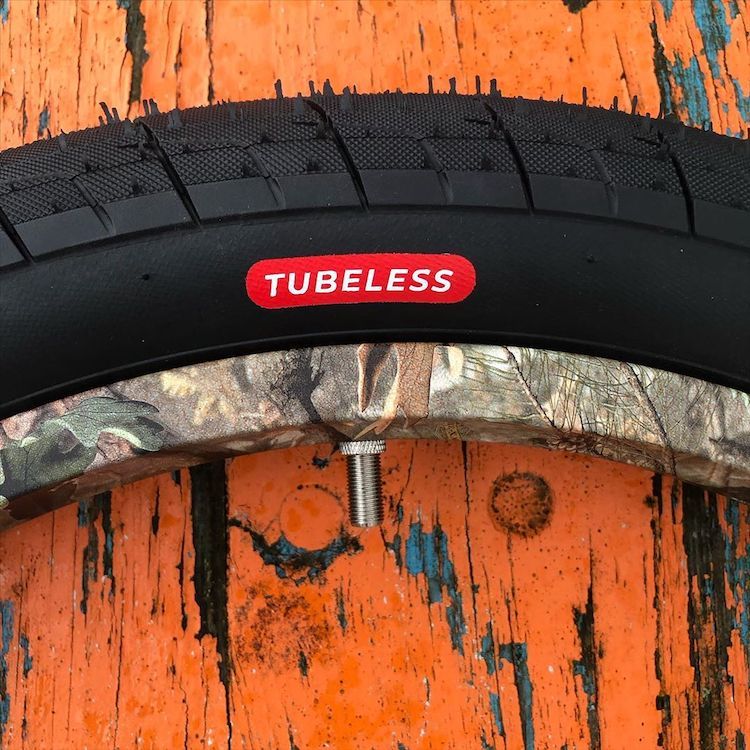1
What do I need to know how to do?
What Tools do I need?
First, verify that your components are tubeless compatible. See Tubeless Tire Compatibility for more information on tubeless tire standards.
3
There are two main methods for adding sealant to the tire:
This method requires a measuring cup. An air compressor is highly recommended.
This method requires a valve with a removable valve core, a syringe, and an air compressor.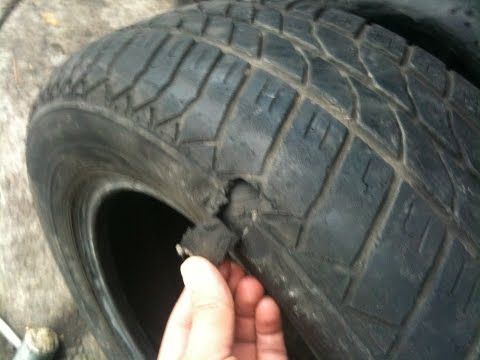
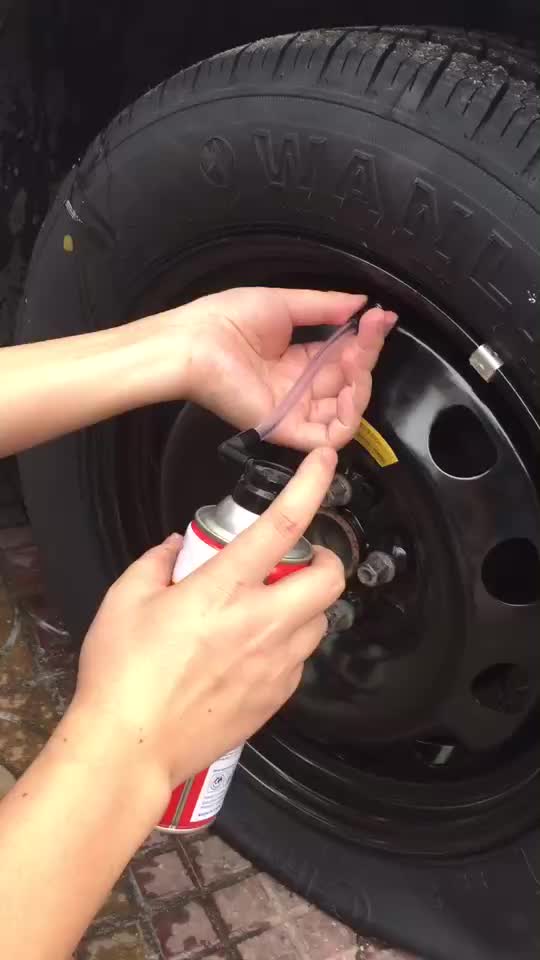
Sealant seeping through the tire bead
The rim strip on this wheel was not adequately sealed. Sealant may, in time, create a seal
4
In general, punctures in tubeless tires cannot be repaired. Punctures in UST tubeless tires, and other tubeless tires with a butyl inner lining, can potentially be repaired using a vulcanizing patch kit such as the VP-1.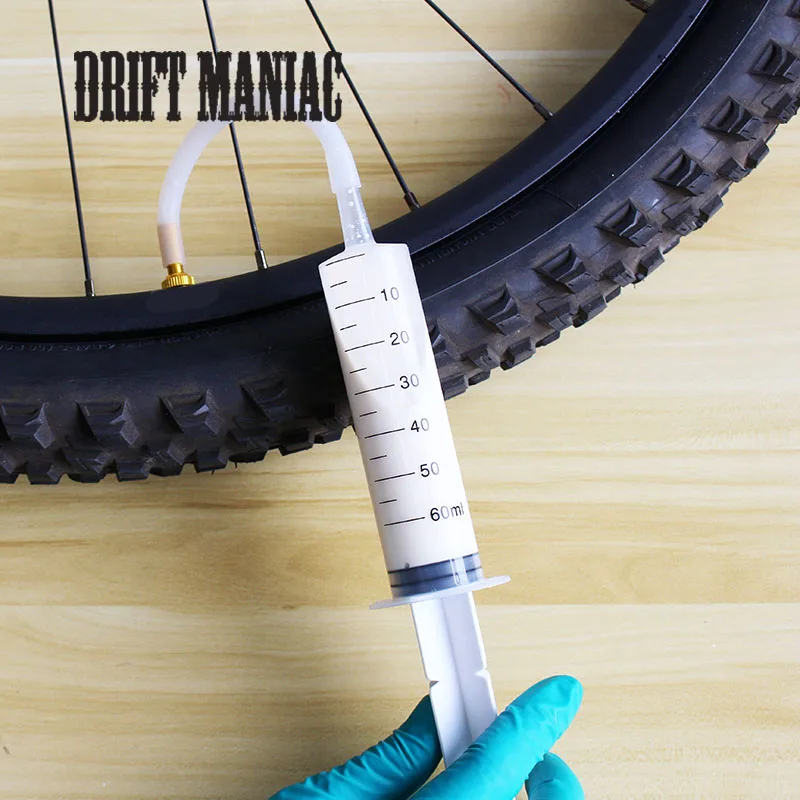 It is not recommended that you attempt to use other types of patches, or attempt to repair other types of tubeless tires.
It is not recommended that you attempt to use other types of patches, or attempt to repair other types of tubeless tires.
See Inner Tube Repair for instructions on using a vulcanizing patch kit.
Jim’s Tech Talk
By Jim Langley
In several recent columns like this one. I’ve offered tool tips and ideas for a common and extremely frustrating issue with some tubeless tire and tubeless-ready rim combinations.
The issue is that, when the tires are installed, the tire beads become locked onto the rim. There are shelves on each side of the rim designed to lock and hold the tire beads in place. The problem is that they hold too well and when it comes time to remove a tubeless tire locked on like this, it can be monumentally difficult to remove.
If you carry a tubeless plug patch kit, such as the ones by Dynaplug (see my recent review) you may never have to remove a tubeless tire to fix a flat on a ride. But you’ll still run into the issue when it comes time to replace the tire, if you work on your own bike and have tubeless road tires and rims with locking beads.
But you’ll still run into the issue when it comes time to replace the tire, if you work on your own bike and have tubeless road tires and rims with locking beads.
Even if you have tire levers that work well on other tires, they usually won’t work for removing the locked on tubeless tires you can run into. The problem with standard tire levers is their tips are too thick to fit between the tire bead and the rim. You can try to jam it in-between but the mechanical advantage of the bead lock designed to not let go no matter what, prevents getting anything too thick between the rim and tire. There isn’t enough space, either.
If you’re lucky, instead of using a tire lever, you can push on the sides of the tire with your hands to try to shove the bead at one spot off the rim shelf there. If you try spots every few inches around both sides of the rim, you might find one spot that releases. And if so, that one free spot will create the slack needed to get the tire off all the way around on that one side. Then you just have to repeat the process on the other side to unlock that bead and remove the tire.
Then you just have to repeat the process on the other side to unlock that bead and remove the tire.
As I wrote in previous Tech Talks about stubborn locked on tubeless tires, I’ve been trying to invent a tool that both fits in-between the tubeless bead and the rim and also has a pinching action to push the bead off the rim. I have not had much success – lots of ideas, but nothing I thought would work with all tires and rim types I would like to use it on (for road and mountain tubeless tires – MTB tires can be much worse than road).
Finally, the other day while fighting to remove a locked on tubeless tire, I had a eureka moment. This tire was even worse than a typical locked on tubeless because I had put a new tube in to fix a flat. The sealant in the tire stuck to the tube gluing it inside the tire and this made it even more difficult to push the tire beads off the rim.
Realizing I couldn’t force this tire off with my hands – or any of the regular bicycle tire tools in my shop – and I have about everything ever made, it dawned on me that I might have a much more basic tool to do the trick.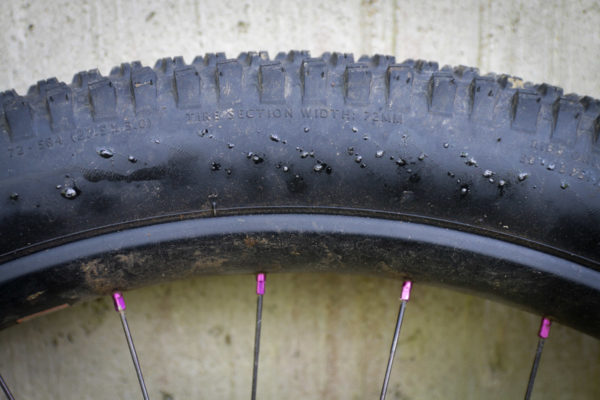
The tool that worked the magic was a good old fashioned putty knife. Here are some photos so you can see the type. With its oversize handle you have a great grip for forcing the tool in between the tire and rim. You have to work at it a bit with the goal of getting the entire width of the blade resting on the rim.
Once the tool’s blade is fully down in between the tire and rim, you can use the tool as a lever and also twist it to get its stiff wide blade to push the tire bead off the rim shelf. You use the tool carefully so as not to jab any sharp edges into the tire or rim. You’re just trying to get the tire bead to move toward the center of the rim.
It took a few tries to free the tire, but the putty knife worked well. I had to be sure to keep it down against the rim and focus on moving the tire not in any way scratching or poking the rim or tire.
If you try this with a new putty knife, you want one that has a blade stiff enough not to bend. That way using it as a lever or twisting it to push the tire the blade will be strong enough to have the desired effect. If the new blade has any sharp edges, be sure to dull them with a file or piece of sandpaper, etc.
That way using it as a lever or twisting it to push the tire the blade will be strong enough to have the desired effect. If the new blade has any sharp edges, be sure to dull them with a file or piece of sandpaper, etc.
I hope this tool tip helps you with locked on tubeless tires. If you give it a try, please comment and let everyone know how it worked. And, please comment with your favorite tools for removing locked on tubeless tires.
Jim Langley is RBR’s Technical Editor. He has been a pro mechanic and cycling writer for more than 40 years. He’s the author of Your Home Bicycle Workshop in the RBR eBookstore. Check out his “cycling aficionado” website at http://www.jimlangley.net, his Q&A blog and updates at Twitter. Jim’s cycling streak ended in February 2022 with a total of 10,269 consecutive daily rides (28 years, 1 month and 11 days of never missing a ride). Click to read Jim’s full bio.
Mounting and dismantling of tires is now cleverly done in the tire shop. And, some 30 years ago, the drivers themselves were engaged in repairing the wheels. For the “experienced”, disassembling a tubeless wheel is not difficult. But what about those who have no repair experience, and in a traffic situation there is no other way out? Such drivers should study the theory of self-breakdown. The acquired knowledge can be put into practice.
Wheel stripping is the process of removing a tire from a rim. To disassemble the wheel, it may be necessary to replace the rubber with a new one, or in the case of an off-season “change of shoes”. And sometimes, you need to disassemble the wheel to repair a tire or disc. The most common are two methods of dismantling.
One of the oldest methods still used by truck drivers. During the operation of the wheels, the tire bead is "welded" to the seat on the disk.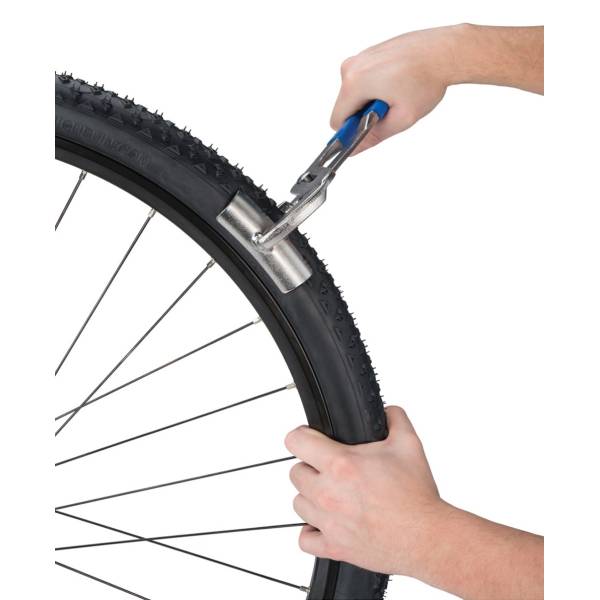 This phenomenon is especially common with tubeless tires. In this case, it is possible to separate two elements that have become attached to each other by hitting a wedge with a sledgehammer. A wedge is a piece of steel thick corner with machined ends so as not to tear the rubber. After a series of blows, the tire and disc are separated.
This phenomenon is especially common with tubeless tires. In this case, it is possible to separate two elements that have become attached to each other by hitting a wedge with a sledgehammer. A wedge is a piece of steel thick corner with machined ends so as not to tear the rubber. After a series of blows, the tire and disc are separated.
In this case, weights must be used. The method is more humane, since it harms the rubber and the disk less (it is not always possible to accurately hit the corner with a sledgehammer). For weight, it is possible to use the mass of the car or your own body. In the second case, in order to increase the pressure, you will have to use a lever structure (pipe or board).
Tires with tubes stick less often (except for truck wheels). Therefore, it is enough to bleed the remaining air, clean the wheel of dirt and start dismantling. Tubeless tires stick a lot. Therefore, a few hours before disassembly, it is recommended to apply a decoking spray, for example, WD-40, to the stuck place.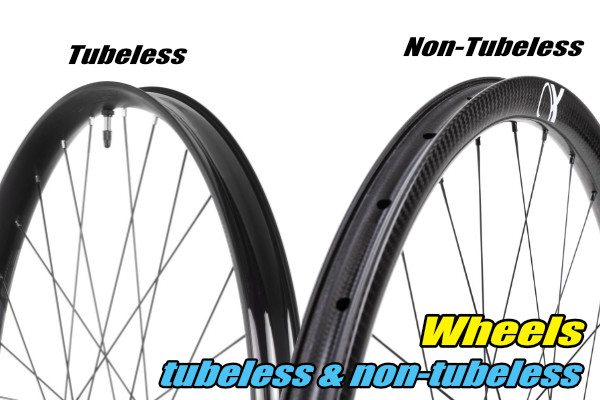 It is also possible to pour a little vinegar on the connection, as professional drivers used to do in the old days.
It is also possible to pour a little vinegar on the connection, as professional drivers used to do in the old days.
To disassemble the wheels at home, it is necessary to prepare the tools. First of all, these are mounting blades 2-3 pieces. For the shock method, you will need a sledgehammer and 1-2 corners. In the case of shockless technology using the weight of the car, you will need: a jack and pieces of boards. Consider the case on the road. The steps are as follows:
 We fix the position with the foot. With the second spatula we pry the tire bead and take out the edge of the rubber from the disk, and so on;
We fix the position with the foot. With the second spatula we pry the tire bead and take out the edge of the rubber from the disk, and so on; Before disassembly, it is recommended to inspect the mounts for chips and burrs. Sharp edges can damage the disc and tire. Never use crowbars or nail pullers. Their sharp edges are guaranteed to tear the tire bead.
Another option is how to disassemble a tubeless wheel yourself using a rack and pinion jack. We tie the edge of the lifting platform to the disk with a wire or cable, and rest its heel against the tire. We raise the disk. In the process of work, we gradually move the jack along the perimeter of the tire. However, this option is dangerous. If the connection breaks, the structure will shatter.
Assembling a tubeless wheel is easy. A few movements with the shoulder blades, and the tire is in place. But, how to pump up such a cylinder, because the tire bead does not have an airtight connection? This will require high air pressure, which will quickly expand the rubber. The compressor will supply the necessary pressure. But in the field there is no compressor. There is an exit.
A few movements with the shoulder blades, and the tire is in place. But, how to pump up such a cylinder, because the tire bead does not have an airtight connection? This will require high air pressure, which will quickly expand the rubber. The compressor will supply the necessary pressure. But in the field there is no compressor. There is an exit.
It is possible to apply two types of pumping. The first is the use of flammable liquids. Pour some gasoline inside the wheel, step back and set it on fire. Hot air will instantly expand the rubber. The second option is a radial tire tie. Wind the towing cable around the protector and twist it with a mount. The tire will expand. Its edges will press against the disk. After that, you can inflate the tire with a foot / hand pump and remove the bandage.
Before you try to disassemble the wheel with your own hands, you should take care of the tool. Keep a couple of mounting spatulas in stock, they can come in handy on the road. The rest: a jack, a pump and a tow rope should always be in the trunk. As can be seen from the material of the article, the disassembly operation can be carried out with an improvised tool.
As can be seen from the material of the article, the disassembly operation can be carried out with an improvised tool.
Content
Each car collided each car with such a problem as punctured wheels. This is a nuisance that can completely change plans if caught on the way. Not everyone knows how to manually disassemble the wheel themselves, so as not to resort to tire fitting services and not to wait for help on the road.
https://www.youtube.com/watch?v=_XG04qEVuBIVideo can't be loaded because JavaScript is disabled )
Situations when you have to change the tire yourself are rare. As a rule, these are:
The disassembly process is the removal of rubber from the disk. Each driver should know how this is done at home in order to quickly solve the problem without resorting to the services of qualified specialists.
Each driver should know how this is done at home in order to quickly solve the problem without resorting to the services of qualified specialists.
If you are interested in how to disassemble the wheel yourself, remember that you will not need special professional equipment, but not every tool at hand will do. For example, using a hammer and pry bar can damage the tire and rim.
A simple set for disassembling wheelsTo remove a tubeless tire, you need to prepare:
After removing the tire, it is important to wipe the rim dry so that it does not interfere with the beading process.
 Loosen the fixing nuts first. After that, it will be possible to completely remove the wheel.
Loosen the fixing nuts first. After that, it will be possible to completely remove the wheel. An important rule that must be taken into account: the removal of the tire from the disk should begin from the place that is located opposite the spool, and then move along the rim. Using this method, you can remove the tire from the disk within half an hour.
To separate these elements from each other, it is better to use a prepared steel angle. The rounded edge will avoid tire and rim damage. It should be driven in so that there is a space between the tire and the wheel. After mounting blades, disassembly is performed.
This allows for precise operation without damaging the camera. It is removed only after the tire is completely removed on one side. At the end of the process, the driver will need to place a new tire and repeat all the steps in reverse order.
It is removed only after the tire is completely removed on one side. At the end of the process, the driver will need to place a new tire and repeat all the steps in reverse order.
Due to the lack of a chamber in the wheel, the tire is hermetically sealed on the rim and filled with air. In fact, she turns into a camera. The advantage of such tires is the slow process of pressure loss, which is characteristic of accidental punctures.
There are a lot of these wheels on the market today. This design allows you to fully control the car in this situation, without losing control, and provides an opportunity to get to the nearest tire shop or home.
Skill is required to disassemble the wheel on the machine and not tear the rubber. All you need is a desire and a minimal set of tools at hand. The most difficult part of the process is pumping the wheel with air. This procedure is required. The tire needs to be in place. This requires a large volume of air, which is unlikely to be able to provide a mechanical pump or a car compressor.
[totalpoll id=”6725″]
The easiest way is to use ether and 10–20 g of gasoline. It is important to use a moderate amount of fuel for the process to be safe. When igniting ether and gasoline, the tire automatically jumps onto the hump wheel.
Important! The wheel must be inflated in parallel with the indicated process so that the tire does not come off.
With a tire changer, it is much easier to carry out all the necessary actions. In this case, a minimum number of tools is required.
Installing a tire on a hump wheelIf the beading is incorrect, the machine can tear the rubber or damage the rim. This must be taken into account when taking any action.
Using the tire changer, it is much easier not only to assemble the wheel, but also to inflate the tubeless tyre. A large volume of compressed air supplied at a fast pace will allow you to easily install the tire on the hump. This method is more correct when beading wheels, as it minimizes the risk of tire and rim damage, and also allows balancing after completion of work.